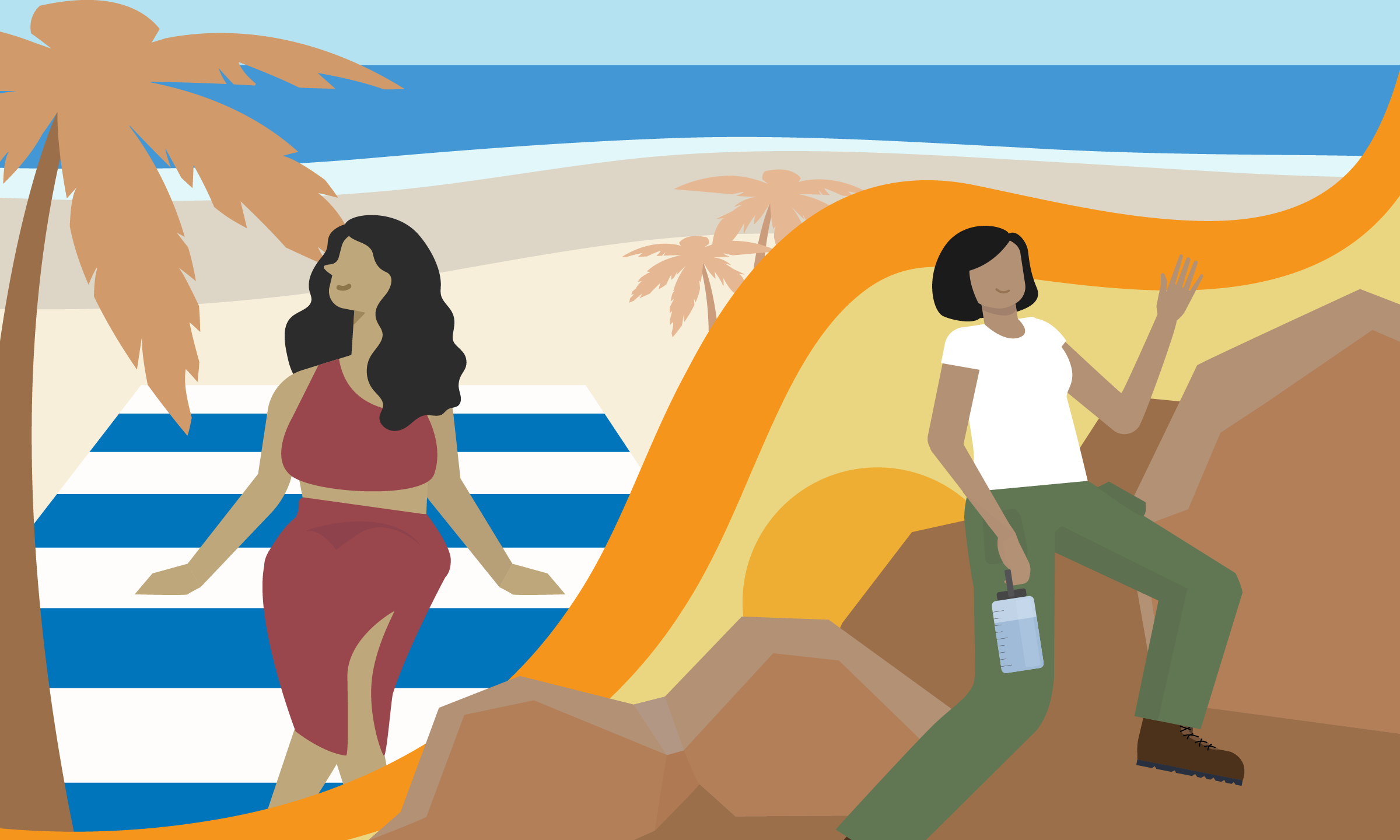
New year, new travel plans. And there’s probably no shortage of trip ideas bouncing around the group chat. Yet, there seems to be a clear divide in the type of trip people want to take: some need a relaxing beach vacation, while others have already added new ski gear to their cart.
Sound familiar? If you’re like most Americans, travel is an essential part of your lifestyle—whether you get away for short weekend jaunts or extended international trips.
In fact, according to our recent survey of 1,000 Americans, more than three-quarters (79%) said they take at least one trip each year, but nearly all (91%) wish they could travel more.
In the year ahead, many will do just that: 56% of Americans plan to take more trips in 2025. And with good reason. Our data shows more than half of Americans still feel like they’re making up for the time they lost during the pandemic: 52% of travelers under 60 said this.
But it's more than just revenge travel; escaping life’s stressors and screens is now a top priority for most Americans. And to many, travel offers a break from the pressures of daily life and digital overload. But what types of trips offer travelers the reprieve they need? Where do they go if escapism means skiing down a mountain to one traveler—and decompressing at the beach to another?
Keep reading to learn what kinds of trips most Americans prefer to take, what motivates—or deters—their travel plans, and how different generations satisfy their curiosity about the world.
Goodbye, list of to-do’s. Hello, ocean views.
So, what will it be: skiing or beach time? That is, adventure or relaxation travel? What do Americans prefer?
First, let’s define each type of travel.
Relaxation travel is associated with serene, escapist environments like beaches and islands, as well as aspirational locations like the Caribbean and Maldives. Meanwhile, Americans associate adventure travel with specific, activity-driven destinations, including visiting other countries and national parks.
And hands down, relaxation trips are the most popular and accessible choice for Americans.
Here’s what travelers told us:
Two-thirds of Americans took a relaxation trip in the past year
Relaxation trips are the most popular type of trip, with nearly two-thirds (65%) of Americans having taken one in the past year. And while nearly half (49%) of Americans expect their number of relaxation trips to stay the same this year, another 41% said they expect to take more trips focused on relaxation.
So, what does relaxation look like? One Gen Xer described his ideal getaway: “My dream relaxation trip would be by a lake, with absolutely no itinerary. The lodging facility would be simple. No wifi. At night, there would be a solo musician either on a guitar or a piano. That's where I would go to read while lounging on a lounge chair.”
Related reading: How to Actually Relax on Your Next Vacation
Our survey showed relaxation trips transcend age and gender (more on those demographics a bit further down). One Gen Zer said she’d want to travel: “ … somewhere hot and sunny [where I can] read at the beach, [hang] with family or friends, and swim in the water. Probably also take a nap. It would be chilling, lazy, and relaxing. A little spa massage later in the day. And most importantly, food.”
Relaxation trips are especially attractive to those who can only get away for a few days:
But shortage of PTO is just one reason for choosing a relaxing vacation over an adventure trip. According to our data, many barriers to traveling are lower for relaxation travel. This includes those who attributed emotional (27% relaxation vs. 33% adventure), health (39% relaxation vs. 45% adventure), and safety (23% relaxation vs. 35% adventure) barriers as to the reasons they chose one type of travel over another.
Women, in particular, reported feeling safer on a relaxation-focused trip: 22% said safety was a barrier to relaxation trips versus 37% to adventure travel.
Those who face health challenges are nearly twice as likely to have taken a relaxation trip (93%) than an adventure trip (49%) in the past year. This is especially true of boomers+: 56% said they were more likely to cite mobility limitations as a barrier to adventure travel.
Budgets play a role, too: more Americans cite financial constraints as the top reason they skip adventure trips (57%) versus relaxation trips (52%).
But once they’re in vacation mode, nearly all Americans seek to disconnect (98%) and prioritize their health (97%).
Relaxation travelers said their top priorities include:
- Unplugging from their phone (85%)
- Taking a mental health break (89%)
- Escaping everyday life (83%)
- Taking a break from work (82%)
- Spending time alone (80%)
These travelers know how to put the away in getaway.
Adventure travelers seek connection and self-discovery
When you think of adventure travel, do active experiences immediately come to mind? You’re not alone. According to our data, two-thirds (66%) of Americans said an activity-focused trip and adventure travel are one and the same. And three-quarters (75%) agreed that to go on an adventure trip, they needed to be active—a sentiment shared consistently across all generations.
Meanwhile, for the 44% of Americans who took an adventure trip in 2024, it wasn’t just about thrill-seeking (though that was part of it). Many sought out adventure travel to experience personal growth: 94% of travelers said they prioritize stepping out of their comfort zones and exploring new activities during adventure travels.
While relaxation trips are the most popular, 37% of Americans have taken both adventure and relaxation trips in the past year. And only 34% feel that they need to choose between one or the other. Even on adventure trips, 82% ensure they have downtime to recharge. According to survey respondents, some destinations are perfectly suited for both: Florida, Hawaii, and Colorado are popular with those seeking the best of both worlds.
Most Gen Zers and millennials travel to get outside their comfort zones—and away from social media
Despite their differences in age, one thing rings true for all generations of travelers: they like to relax on vacation. Indeed, relaxation trips are a favorite among Gen Zers (71%), millennials (65%), Gen Xers (64%), and boomers+ (77%) alike.
And while all travelers—to varying degrees—enjoy trips centered on adventure, Gen Zers are most likely to take those types of trips: 64% of Gen Zers said this. In contrast, 52% of millennials, 44% of Gen Xers, and just 27% of boomers+ agreed.
So, how do the generations decide where to go and what kind of trip to take? According to survey data TripIt published in early 2024, 54% of Americans source trip ideas from social media. Gen Zers and millennials, in particular, rely on this source: more than twice as many younger travelers rely on social for trip inspiration versus their older counterparts.
And that goes for both adventure and relaxation travel. Two-thirds (66%) of Gen Zers and more than half (52%) of millennials look to social for adventure trip inspiration; more than half (57% of Gen Zers and 59% of millennials) source ideas for relaxation-focused trips.
But once those trips are planned, younger travelers are ready to unplug. Nearly three-quarters of younger travelers want to stay offline once they’re traveling. Only about half said they enjoy posting to social media during a trip.
So if they’re not posting about their trips, what are younger travelers up to?
Trying new things, for starters: 83% of millennials and 81% of Gen Zers said they're motivated to step outside their comfort zones while traveling. Gen Zers are especially keen to connect with people from different backgrounds—more so than older generations. Nearly three quarters (72%) of Gen Zers prioritize this, followed by millennials (66%), Gen Xers (64%), and boomers+ (61%).
Part of that social connection comes from bonding over common interests. Gen Zers are likely to have plans for pop-culture (49%) or entertainment-focused travel (47%), including events like pro and e-sports, concerts, fashion shows, and conventions. But millennials hold rank here: 53% said they are planning pop culture-inspired getaways.
Younger travelers also want to get back to nature. According to one millennial respondent, her ideal trip is “…getting lost in the woods to be one with nature. Some of my favorite activities include watching the animals enjoying life in their natural habitat, camping in the forest, trailing, [and so on].”
In fact, more than three-quarters (80%) of Gen Zers want more outdoor trips; 58% want to take more road trips and 36% are prioritizing activity-focused trips.
One Gen Z respondent shared that he enjoys “traveling to a destination that I have never experienced before and exploring the culture and activities to do in that area. For example, going to Denver, Colorado and hiking and exploring areas I can not see back home.”
Gen Zers are also the most likely to plan wellness retreats: 18% of Gen Zers are planning this kind of trip, followed by 13% of Gen Xers.
So, where will your group chat decide to go? The answer depends on what your fellow travelers want to get out of the trip: unplugging from everyday life, or forging new connections—with others and themselves? Or maybe, like many Americans, they’re seeking a bit of both.
Methodology: TripIt partnered with Edelman Data & Intelligence to conduct a 10-minute, quantitative survey between November 7-13, 2024, fielded among 1,000 Americans, nationally representative by age, gender, ethnicity, and region. For certain statistics in the report, younger generations (Gen Z and millennial) and older generations (Gen X and boomer+) were combined to accommodate sample size limitations.

